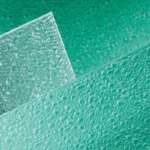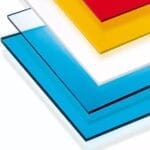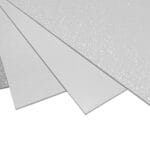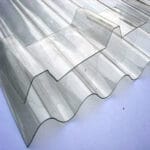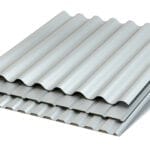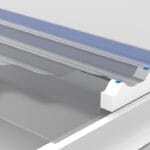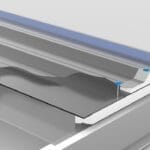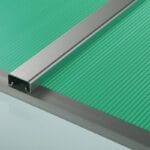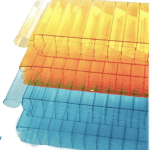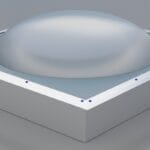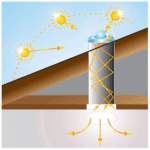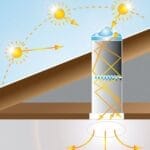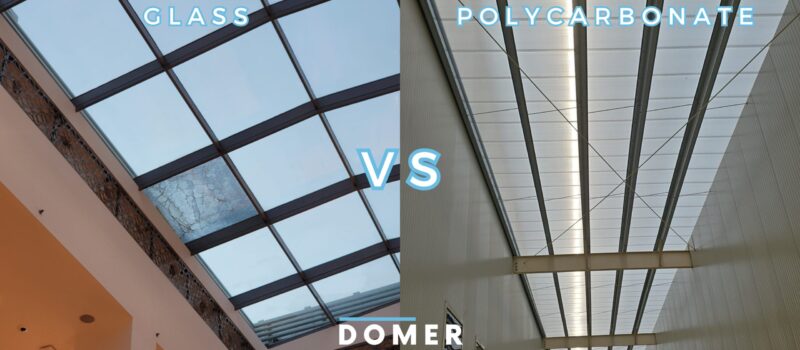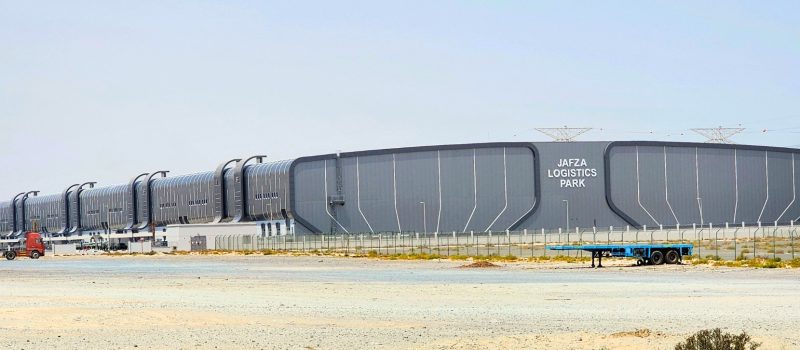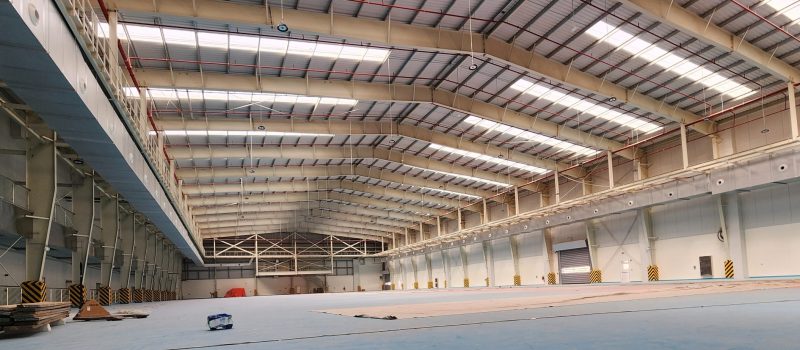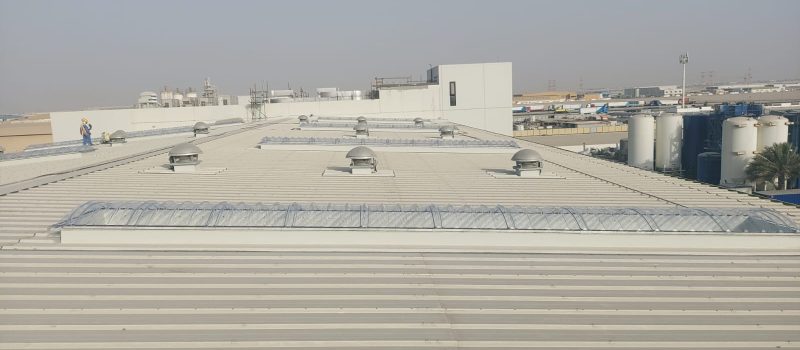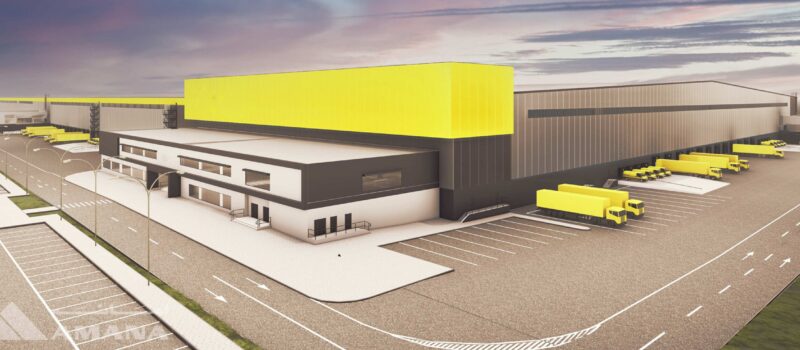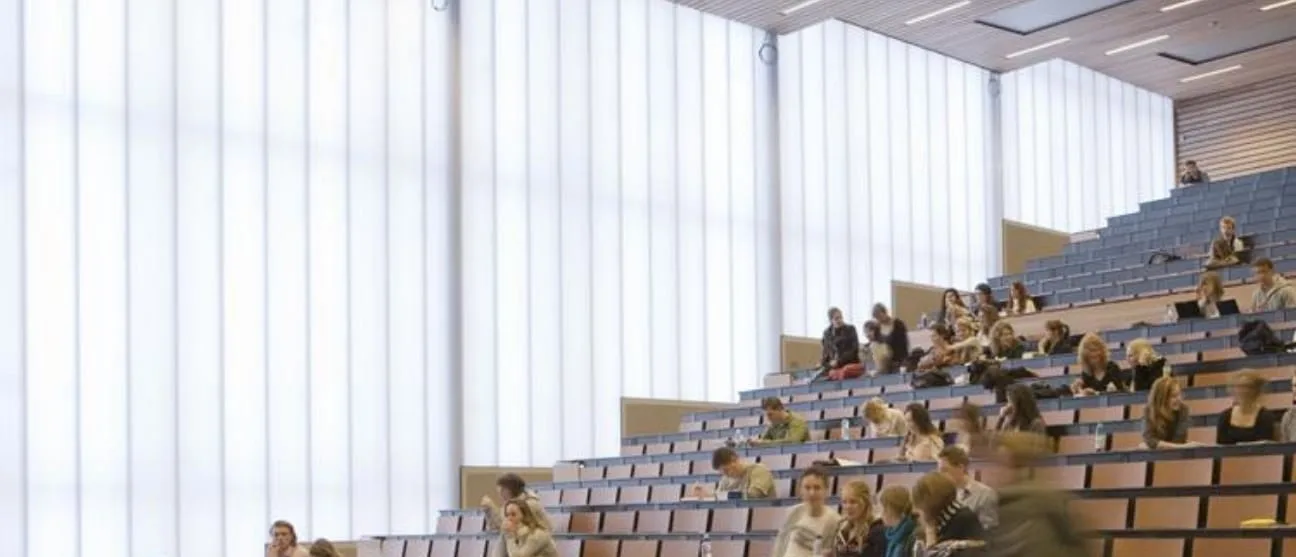 University classroom naturally lit by polycarbonate ContiWall facade, enhancing student productivity.
University classroom naturally lit by polycarbonate ContiWall facade, enhancing student productivity. Modern educational design is embracing natural light as a powerful tool to enhance student success. In both Gulf countries and Europe, architects and facility managers are increasingly integrating skylight systems in schools and universities to create brighter, healthier learning environments. From rooftop glazing to translucent polycarbonate facade elements, these daylighting strategies are proving to improve student productivity, well-being, and sustainable performance. This article explores why daylight is vital in education, how skylights and polycarbonate panels benefit schools, and what research and case studies reveal about designing with natural light for optimal student outcomes.
Daylighting as Key to Student Success
Children and young adults spend a significant portion of their day indoors at school. Research has made one fact clear: the availability of natural daylight in classrooms can dramatically influence how well students learn and feel. Numerous studies link increased daylight exposure to better academic performance, health, and even attendance. For example, an influential study of over 21,000 student records found that students in classrooms with abundant daylight progressed 20% faster in math and 26% faster in reading compared to those in dimly lit classrooms. In other school districts analyzed by the same research, students in the brightest classrooms scored 7–18% higher on standardized tests than those in classrooms with the least daylight. This statistically compelling connection suggests that bringing sunlight into learning spaces isn’t just an aesthetic choice it’s fundamental to academic achievement.
Daylighting benefits go beyond test scores. Evidence suggests that daylight greatly amplifies student performance and even attendance rates. Schools that introduce more natural light often report improved student alertness and lower absenteeism, as healthier indoor lighting supports students’ circadian rhythms. In fact, one European study spanning 12 countries (the SINPHONIE project) found that various classroom daylighting parameters (such as larger window-to-floor area ratios and well-oriented windows) were positively correlated with better student test scores. Simply put, brighter classrooms tend to foster better learning outcomes.
How Natural Light Improves Productivity and Well-Being
Abundant daylight doesn’t just boost grades it also nourishes student health and well-being. Human biology is finely tuned to the sun’s cycle, so the indoor environment’s lighting can affect mood, behavior, and health. Studies have shown that children in windowless classrooms can suffer disrupted hormone levels. For instance, research in Sweden by Küller and Lindsten observed that students without classroom windows had abnormal cortisol patterns (a stress-related hormone), which could negatively impact their concentration and health. This finding highlights that lack of natural light is a stress factor; conversely, well-daylit spaces help keep stress hormones in balance, supporting calmer, more focused behavior.
Natural light is also linked to positive mood and energy. Daylight exposure triggers the release of serotonin and helps regulate the body’s melatonin, which means students in naturally lit environments often experience better mood and sleep quality. In northern European countries, educators are keenly aware of the risks of Seasonal Affective Disorder (SAD) during dark winters. Adequate daylight in schools can combat these “winter blues,” as medical research shows that seasonal lack of daylight can induce depression, and bright light is an effective remedy. By designing classrooms to capture daylight even in the darker months, schools support the mental health of students and staff. In essence, sunlit classrooms create happier students: increased exposure to natural light has been linked to improved mood, higher alertness, and overall well-being and productivity for learners.
Visual comfort is another crucial aspect. Classrooms flooded with soft, balanced daylight tend to reduce eye strain and headaches compared to those lit by harsh fluorescents. Daylight that is well-diffused (for example, through translucent panels or skylights) minimizes glare on whiteboards and screens while providing high-quality light. This comfortable lighting environment can improve concentration and reduce fatigue. As one architecture publication noted, clear and translucent materials like polycarbonate can be combined in school facades to create a pleasant naturally lit learning environment. Students and teachers are able to see and read with ease, which directly supports better academic engagement.
In summary, daylighting in schools offers a multifaceted boost: it sharpens focus and cognitive function, improves physical health by aligning with natural body rhythms, and lifts spirits. These benefits translate to measurable outcomes from higher test scores to fewer sick days, that underline why investing in good daylight design is investing in student success.
Skylight Systems in School Design
To harness these benefits, architects are implementing skylight systems in schools and universities as a top daylighting strategy. Skylights are windows in the roof or ceiling that bring sunlight from above into the heart of a building. They can dramatically transform interior spaces that traditional windows cannot reach, such as central corridors, libraries, or large lecture halls. In schools that span large footprints, skylights ensure that even classrooms and labs away from exterior walls can receive natural light from overhead.
One advantage of Domer’s skylights is the quality of light they deliver. Overhead daylight tends to be diffuse and uniform, especially when designed with proper glazing or diffusers. When a skylight is outfitted with materials that scatter sunlight (like Contiroof or Contiwall polycarbonate systems), the incoming light spreads evenly without harsh hot spots. For example, a well-designed skylight that diffuses daylight throughout a classroom, with controls for brightness, was shown to improve students’ reading and math performance compared to classrooms without such a skylight. By illuminating learning spaces from above, skylights create an uplifting ambiance that keeps students alert and engaged.
Modern skylight systems come with features that address common concerns in the Gulf and European contexts alike. High-performance skylights often use insulated glazing or multi-layered panels to prevent unwanted heat gain or loss, an important factor in Gulf climates with intense sun and in European winters. Studies show that optimal daylight can boost children’s learning abilities by up to 15%. In one new school building in Germany, architects installed a series of skylight modules in a large central atrium, flooding the three-story space with daylight. Even on overcast days the atrium receives plenty of diffused natural light, and the design helped the school achieve Passive House-level energy performance. The lesson is clear, skylights are not just roof windows, but an integral part of a high-performance educational environment.
For facility managers, it’s worth noting that skylight systems can be implemented in both new construction and retrofits. Many older school buildings (including those built in the mid-20th century) have limited natural light by design, relying heavily on electric lighting. Retrofitting such a building with skylights or light lumina tunnels can dramatically brighten formerly gloomy interiors. Of course, skylight additions must be carefully planned to avoid leaks and to control solar gain. Techniques like external shading, low-e coatings, or translucent covers help tailor the light intake. When done right, introducing skylights can transform libraries, hallways, and multipurpose rooms into vibrant, daylit spaces without overtaxing the cooling systems even in hot climates. The design flexibility of modern skylights including options for automated blinds and specialized light sensors allows schools to reap the benefits of sunlight during school hours and modulate it as needed.
Polycarbonate Facades and Panels for Schools
In bringing daylight into educational buildings, traditional glass is no longer the only nor the favorable option. Polycarbonate panels for schools and colleges and universities have emerged as a popular solution to create bright yet thermally efficient facades and skylights. Polycarbonate is a lightweight, extremely durable thermoplastic about 250 times stronger than glass in impact resistance, making it ideal for the demanding environment of schools. Whether used in a curtain wall, roof light, or cladding system, polycarbonate can safely withstand the occasional basketball hit in a gymnasium or stray football in a courtyard. This durability comes with the benefit of lighter weight, reducing the structural support needed and often lowering construction costs.
One of the greatest advantages of polycarbonate in school design is its ability to diffuse natural light. Unlike clear glass which can cause glare or hotspots, polycarbonate panels (especially in Contiroof and Contiwall configurations) scatter sunlight, creating a soft, even glow inside classrooms. This diffusion eliminates the distraction of sharp glares and makes it easier for students to see whiteboards or computer screens. At some modern schools in the United States, architects combined conventional glazing with translucent polycarbonate wall panels to achieve a comfortably lit learning environment by day, while turning the building into a softly glowing beacon by night. The polycarbonate facade there not only enhances the interior light quality but also contributes to the school’s aesthetic and identity.
Polycarbonate systems are also engineered with insulation and solar control in mind. Multiwall polycarbonate panels trap air between layers, providing better thermal insulation than single-pane glass. This is crucial in Gulf countries where keeping heat out is a priority the panels can admit plenty of daylight without the full brunt of the desert heat. All Domer polycarbonate facades include UV-resistant layers that block harmful ultraviolet rays and reduce infrared heat transmission, protecting occupants and interior finishes from sun damage and excessive heat. In European climates, the insulating value of polycarbonate helps maintain warmth in winter, so schools can enjoy sunlight and maintain energy efficiency. The material can be tailored in translucency and tint as well: clear, crystal or opal white panels offer high light transmission with diffusion, whereas tinted polycarbonate can cut down brightness and solar gain to comfortable levels. This flexibility allows architects to “tune” the façade to the local climate and the orientation of each facade or roof.
Another reason polycarbonate is well-suited for educational facilities is the privacy it affords. Especially for schools in dense urban areas or for spaces like science labs or gymnasiums, translucent polycarbonate walls let in daylight while obscuring direct lines of sight, maintaining privacy and security. As one industry source notes, translucent polycarbonate walls provide soft, optimized light while preserving privacy and insulation, making them advantageous for K-12 schools and universities alike. Students benefit from daylight without the distraction of seeing outside or being seen from the outside, which can be important for exam rooms or other focused learning spaces.
It’s no surprise, then, that polycarbonate wall systems are frequently recommended for educational buildings pursuing daylighting. One of the most commonly recommended polycarbonate wall systems for universities, colleges, and schools is the Contiwall. This system is praised for its high-performance multiwall panels that offer superior light diffusion and thermal insulation. In practice, installing a system like the ContiWall means a school can have an entire facade or courtyard enclosure made of translucent polycarbonate, bathing interior corridors and classrooms in natural light while keeping the building envelope thermally efficient and weather-resistant. Such systems typically integrate into the building’s frame without exposed fasteners, ensuring a clean, modern look a desirable feature for architects aiming for both form and function.
In sum, polycarbonate panels provide a trifecta of benefits for school design: resilience, diffuse daylight, and energy efficiency. They allow architects to get creative with daylighting, from vibrant skylight domes to entire polycarbonate facades that turn schools into lanterns of learning. And importantly, they do so while meeting the safety, cost, and maintenance concerns of facility managers. ContiRoof Polycarbonate does not shatter like glass, requires little upkeep, and comes in modular standing seam system that is faster to install and 100% weather tight. For schools in seismic zones or those concerned with storm impact, the material’s toughness and system tightness are an added peace of mind.
Sustainable Design and Energy Savings
Daylighting strategies align closely with the goals of sustainable design, a priority in both the Gulf and Europe. By maximizing use of natural light, schools can significantly reduce their reliance on artificial lighting during the day, cutting electricity consumption and costs. This is a tangible benefit for facility managers watching utility bills. According to one case, simply by using behavior changes and daylight sensors, “Green Schools” programs saved thousands of dollars annually in energy, funds which could be redirected to educational resources. Introducing skylights and translucent walls is a long-term investment that can yield energy savings for decades by offsetting electric lighting needs. Translucent polycarbonate walls in particular contribute to energy efficiency not only by lighting interiors but also by providing an extra layer of insulation. Their multiwall design helps keep cooling loads down in hot weather and retains heat in cooler weather, stabilizing indoor temperatures.
Sustainability certifications and standards encourage the use of daylight. For instance, designs that achieve certain daylight levels can earn points in LEED (Leadership in Energy and Environmental Design) and similar green building rating systems. Translucent panel systems often qualify for such credits. Moreover, lowering electric lighting use also reduces a building’s carbon footprint and heat output (since lights emit heat), which in turn eases the air conditioning burden in Gulf climate schools. It’s a virtuous cycle: more daylight means less artificial light and often a more balanced thermal environment, which means less air conditioning or heating required.
There’s also a life-cycle sustainability aspect. The improved well-being and performance of students in daylight-rich schools contribute to a more sustainable educational outcome, students who are healthier and more productive are likely to have better long-term success. This human-centered sustainability is gaining traction. School administrators now recognize that a building’s environmental quality directly affects student outcomes. In fact, a comprehensive study in the UK (the HEAD Project) found that the physical characteristics of classrooms (including lighting, temperature, and air quality) explained 16% of the variation in students’ learning progress over a year. Lighting was one of the most influential factors identified. Designing sustainably therefore isn’t only about energy and dollars saved; it’s about creating an optimal learning ecosystem.
Architects in Gulf countries and Europe sometimes face different challenges, but the goal of sustainable, daylit schools is shared. In the GCC region, projects often integrate innovative shading devices, solar-control films, or high-performance polycarbonate facades to balance copious sunshine with comfort. The result can be striking: schools that are filled with daylight yet still cool and glare-free, even under the Arabian sun. In Europe, sustainable school design might focus on maximizing weaker winter sunlight using larger skylights, south-facing clerestory windows, and reflective interior surfaces to spread light. Both regions also consider the angle of the sun: for instance, north-facing skylights provide consistent, soft illumination (useful in the bright Gulf to avoid direct heat, and in Europe to catch diffuse daylight from the sky). Meanwhile, east-west exposures might need shading to prevent low-angle morning or afternoon sun from causing glare or overheating. By addressing these climate nuances, architects ensure that daylighting strategies truly enhance sustainability rather than inadvertently cause discomfort.
Designing for Gulf and European Climates
When implementing skylight and facade systems, architects in Gulf countries and in Europe must adapt to their specific climate requirements. In the Gulf’s hot, sunny climate, the priority is harvesting daylight while minimizing heat transmission. This is where material choice and system design become critical. Polycarbonate skylights and facades can be specified with reflective coatings, frit patterns, or multiwall structures that filter out a portion of the infrared radiation and increases heat insulation. Facility managers in, say, Dubai or Riyadh might opt for skylights with excellent Thermal Performance, choosing polycarbonate panel systems with high insulation (some panels have U-values comparable to double or triple glazing) will keep cooling loads manageable. Additionally, maintenance in sandy or extreme conditions is considered many polycarbonate systems have smooth surfaces that shed dust and are easy to clean, which is a boon in desert environments.
In contrast, European projects whether in the Mediterranean or Scandinavia might focus on maximizing light intake to counteract shorter, overcast days. For example, schools in Northern Europe often feature large skylight atriums or tall window bands to capture as much daylight as possible during winter. In those cases, polycarbonate panels with high light transmission are desirable. Architects might design south-facing facades with polycarbonate and glass to absorb the low-angled winter sun, sometimes complementing them with solar gain in mind (using the sun’s warmth to help heat the building on cold days). However, even Europe deals with summer heat waves, so versatility is important.
Regional building standards also play a role. European Union directives push for nearly zero-energy buildings, which encourages daylight use to cut lighting power, as well as good insulation to reduce heating demand. In Gulf nations, green building standards (like Estidama in Abu Dhabi or QSAS in Qatar) award credit for effective daylighting and solar control. Both regions increasingly recognize the link between sustainable design and occupant well-being, aligning policy with what research has shown, that daylight is indispensable for healthy, high-performing learning spaces.
Real-World Case Studies and Success Stories
Around the world, many educational institutions have demonstrated the positive impact of skylight systems and polycarbonate facades. A striking example comes from a newly built university library in the UAE, where a series of dome skylights made of multi-layer polycarbonate were installed. The design team reported that students flock to the naturally lit reading areas beneath these skylights, noting improved concentration and longer study periods compared to the old library (which had no skylights). By introducing controlled daylight, the library not only saved on energy costs but also became a favored spot on campus for collaboration and study. Similarly, a college in Oman retrofitted parts of its roof with pyramid skylights and saw a reduction in lighting electricity use by about 20% annually, all while student feedback on the environment’s quality rose significantly.
In Europe, one pioneering project is the Hessenwald Cooperative School in Germany. As mentioned earlier, it features a central atrium illuminated by dozens of modular skylights. Teachers at this school observed a notable improvement in student attentiveness in the open atrium learning zones, attributing it to the abundance of natural light and fresh air. Notably, the school achieved a 15% boost in learning outcomes after one year in the new facility, aligning with the studies that optimal daylight can raise performance. Another example comes from the Netherlands, where an architecture firm designed a primary school with an entirely translucent polycarbonate facade wrapping the gymnasium and art studios. This design floods those spaces with daylight while insulating against the chilly Dutch winters. The school reported that the transparent design piqued students’ curiosity and kept them more connected to the outside world’s rhythm they could see changes in daylight and weather as gentle variations of light through the walls, indirectly teaching them about the environment.
The success of these projects underscores that there is no one-size-fits-all solution, rather, the best results come from customizing the skylight and wall systems to the school’s pedagogical needs and local climate. Nonetheless, the common thread is that incorporating generous natural light has elevated the quality of education spaces. Students are more engaged, teachers report better visibility and morale, and schools stand as icons of sustainable architecture in their communities.
Conclusion: A Brighter Future for Education
The evidence is overwhelming and the path is clear: designing schools and universities with abundant natural light can measurably and meaningfully improve student outcomes. By utilizing skylight systems, clerestories, and polycarbonate facades, architects can create spaces that are not only energy-efficient and cost-saving, but also deeply nurturing to the students and teachers within. In an era focused on sustainable design and wellness, daylighting is a cornerstone that checks all the boxes, it lowers energy use, connects building occupants to nature’s rhythms, and boosts academic performance and well-being.
For architects and facility managers in the Gulf region, this means embracing new technologies to control sunlight in a harsh climate, turning a potential challenge into an asset. For their counterparts in Europe, it means reimagining even historic school buildings to open them up to the sky, and ensuring that no student sits in a dark corner. The tools of the trade, from advanced polycarbonate panel systems like the Domer ContiWall or ContiRoof to innovative skylight designs make it easier than ever to balance light, heat, and comfort. The payoff is seen in brighter smiles, more attentive classrooms, and greener, future-ready campuses.
In the end, the importance of skylight systems in schools and universities goes beyond architecture, it speaks to the kind of learning environments we want for the next generation. By literally and figuratively shining a light on students, we empower them to grow, learn, and thrive. The message to take forward is simple: let the light in, and watch education flourish.
Interested in harnessing the power of natural daylight for your educational project?
Contact our daylighting experts today to arrange a meeting. Discover tailored skylight systems, polycarbonate facades, and specialized engineering services that will elevate your school or university’s environment, productivity, and sustainability.



